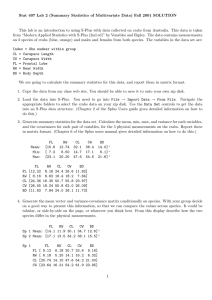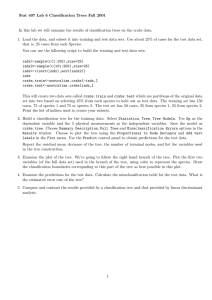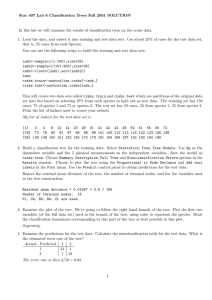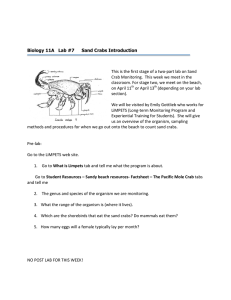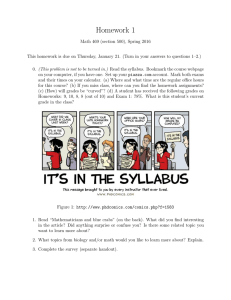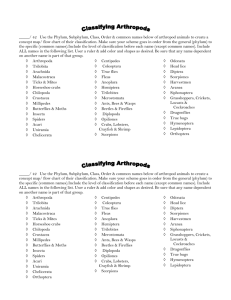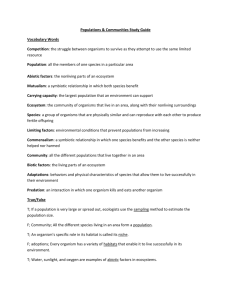OBSERVATIONS ON DUNGENESS CRABS SUBJECTED TO WIND STRESS INTRODUCTION
advertisement
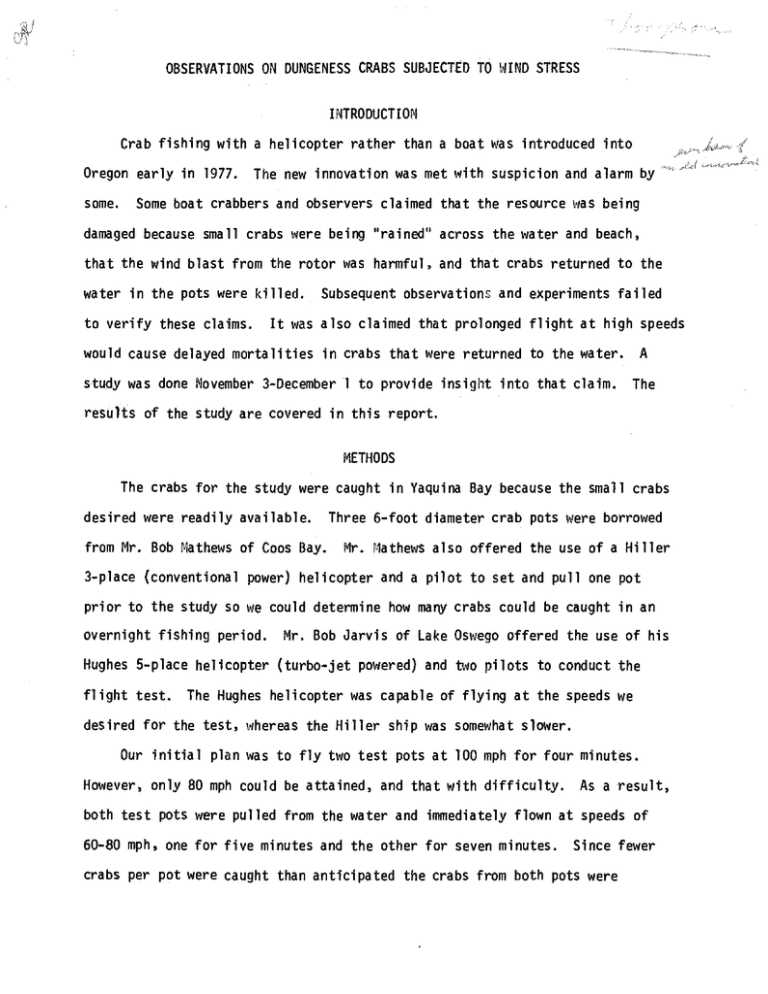
ext OBSERVATIONS ON ON DUNGENESS DUNGENESS CRABS CRABS SUBJECTED SUBJECTED TO TO WIND WIND STRESS STRESS OBSERVATIONS INTRODUCTION INTRODUCTION Crab fishing with helicopter rather than aa boat introduced into into Crab fishing with a a helicopter rather than boat was was introduced Oregon early in in 1977. 1977. The The new new innovation innovation was was met met with with suspicion suspicion and and alarm by'"' Oregon early alarm by some. some. Some boat crabbers crabbers and that the Some boat and observers observers claimed claimed that the resource resource was was being being damaged because small sma 11 crabs bei ng "ra i ned" across the wa ter and beach, damaged because crabs were were being "rained" across the water and beach, that the the wind the rotor harmful, and that crabs that wind blast blast from from the rotor was was harmful, and that crabs returned returned to to the the were killed. killed. water in in the the pots pots were water to verify verify these these claims. claims. to Subsequent observations and Subsequent observations and experiments experiments failed failed It It was was also also claimed claimed that that prolonged prolonged flight flight at at high high speeds speeds would delayed mortalities in crabs crabs that that were returned to to the the water. A would cause cause delayed mortalities in were returned water. A done November November 3-December 1 to to provide provide insight insight into into that that claim. study study was was done 3-December 1 claim. The The results of of the the study study are are covered covered in in this this report. report. results METHODS METHODS The crabs for for the the study study were in Yaquina because the the small The crabs were caught caught in Yaquina Bay Bay because small crabs crabs desired were were readily readily available. available. Three Three 6-foot 6-foot diameter diameter crab crab pots pots were were borrowed borrowed desired from Bob Mathews Mathews of of Coos Coos Bay. Bay. from Mr. Mr. Bob Mr. Mathews offered the the use use of of aa Hiller Mr. Mathews also also offered Hiller 3-place (conventional (conventional power) power) helicopter pilot to to set set and pull one pot 3-place helicopter and and a a pilot and pull one pot prior to the study could determine how many in an prior to the study so so we we could determine how many crabs crabs could could be be caught caught in an overnight fishing period. period. overnight fishing Mr. Bob Bob Jarvis Jarvis of of Lake Lake Oswego Oswego offered offered the the use use of of his his Mr. Hughes helicopter (turbo-jet (turbo-jet powered) powered) and two pilots pilots to to conduct the Hughes 5-place 5-place helicopter and two conduct the flight test. flight test. The The Hughes Hughes helicopter helicopter was was capable capable of of flying flying at at the the speeds speeds we we desired for the the test, test, whereas whereas the the Miller Hiller ship ship was was somewhat somewhat slower. slower. desired for Our initial plan plan was to fly pots at Our initial was to fly two two test test pots at 100 100 mph mph for for four four minutes. minutes. However, only 80 80 mph mph could could be be attained, attained, and and that that with with difficulty. difficulty. As As aa result, result, However, only both test pots pots were pulled from immediately flown flown at of both test were pulled from the the water water and and immediately at speeds speeds of 60-80 one for for five five minutes minutes and and the the other other for for seven seven minutes. minutes. 60-80 mph, mph, one Since fewer Since fewer crabs pot were than anticipated the crabs both pots pots were crabs per per pot were caught caught than anticipated the crabs from from both were -2- combined in the the holding holding tanks. tanks. combined in Crabs a third third pot pot were were used used as as aa control. control. Crabs from from a These the fishing site to to the the laboratory laboratory at These were were flown flown from from the fishing site at speeds speeds up up to to 40 40 mph, mph, but for for only but only aa few few seconds. seconds. The control crabs were out The control crabs were out of of the the water water for for about about one one minute. minute. The was partly partly sunny sunny and and the the temperature temperature 55° 55° FF during during the the flight. flight. The weather weather was The crabs were exteriorly completely completely dry dry when landed, and The test test crabs were exteriorly when landed, and were were docile docile before handling. transferred from from the the pots pots to to the the holding tanks in in before handling. They They were were transferred holding tanks aa tub tub of of water water to to reduce reduce fighting. fighting. Even with this precaution precaution aa few few legs legs were Even with this were lost the transfer. transfer. lost during during the The crabs were held in in 4x4 tanks supplied supplied with The crabs were held 4x4 foot foot fiberglass fiberglass tanks with aeration aeration and running sea sea water water from from Vaquina Yaquina Bay. Bay. and running The hardshell hardshell and The and softshell softshell crabs crabs were were segregated into into separate separate tanks tanks and and fed fed clams clams twice twice weekly. weekly. segregated Dead Dead crabs crabs were were removed detected, the the shell shell width width measured, measured, and and any any injuries injuries noted. noted. removed when when detected, Upon Upon termination termination of of the the study study the the surviving surviving crabs crabs were were measured measured and and shell shell condition condition noted. noted. The study was was run run for for 28 28 days. days. The study RESULTS RESULTS Tables Tables 11 and and 22 summarize summarize the the results results of of the the study. study. Three Three crabs crabs died died in in each the mortality in the the control 10.3% each group, group, but but the mortality rate rate was was 4.6% 4.6% in control group group and and 10.3% in in the the test test group. group. The shell shell width of the the crabs crabs that that died died was was 165, 165, 155 155 and and The width of 153 in the the control control group group and and 155, 155, 142 142 and and 108 108 mm mm in in the the test test group. group. 153 mm mm in of the six mortalities mortalities occurred first two two weeks. weeks. of the six occurred within within the the first Five Five Mortalities were Mortalities were equal hardshell and and softshell softshell crabs. crabs. A chi-square test test corrected corrected for for A chi-square equal for for hardshell showed no no significant significant difference difference in in mortality mortality rate rate between between the the continuity showed continuity and those those in in the the control control group. group. experimental group of of crabs crabs and experimental group One complication interfered with with the the control c,ontrol group. group. One complication interfered On 15 of the study On day day 15 of the study the the in the the standpipe standpipe in the tank tank of of hardshell hardshell crabs crabs was was dislodged dislodged allm1ing allowing all all the -3- - 3- water to to drain drain out. out. all all appeared appeared dead. dead. The out of for at least 24 24 hours hours and The crabs crabs were were out of water water for at least and However, six of of the the crabs crabs reacted reacted slightly slightly when when stimulated. stimulated. However, six These were returned returned to to the the refilled refilled tank, tank, and and survived survived to to the the end end of of the the study. study. These were We that all the crabs in this have survived the water We assume assume that all of of the crabs in this tank tank would would have survived had had the water not drained drained out. out. not Table 1. Summary Table 1. Summary of of Wind Wind Stress Stress Test Test Control Hardshell Softshell No. Crabs Crabs No. Test Hardshell Softshe11 17 17 48 48 17 17 12 12 121-176 121-176 90-169 90-169 131-162 131-162 121-165 121-165 Mean Size (mm) Mean Size (mm) 150.6 150.6 135.1 135.1 146.0 146.0 140.7 140.7 No. mortal i ties No. mortalities 1 1 22 2 2 1 % % mortality mortality 5.9 5.9 4.2 4.2 Si ze Range Range (mm) (mm) Size (%) Total mortality mortal i ty (%) Total 1 11.8 11.8 4.6 4.6 8.3 8.3 10.3 10.3 Table 2. Timing of Mortalities Table 2. in Wind Wind Stress Stress Test Test Timing of Mortalities in Week Week Control tàntrol Hardshell Softshell Softshell l-lardshell Hardshell Hirdshell Test Test Softshell Sot tshell 11 11 00 1 1 00 22 0 0 22 1 1 0 0 33 00 00 0 0 0 44 0 0 00 0 0 1 1 One the pots the control into the the ground One of of the pots originally originally slated slated for for the control crashed crashed into ground in transit transit to to the the landing landing site. site. in The pot pot contained contained nine nine crabs, crabs, but but was was not not The included in the the study. study. However, However, after after 25 25 minutes minutes out out of of the the water water we we decided decided included in hold and observe the the crabs crabs anyway. anyway. to hold to and observe One very soft soft crab crab was was killed killed on on impact, impact, One very -4-4- but only only one one other other died died during during the the study study period. period. but The that was The single single pot pot that was fished fished overnight overnight for for 18 18 hours hours prior prior to to the the study study 31 crabs; crabs; 15 15 hardshell hardshell and and 16 16 softshell. softshe11. contained 31 contained crabs had had died died after after 31 31 days. days. crabs Only one of of the the softshell softshe11 Only one None the hardshell hardshell crabs crabs died. died. None of of the DISCUSSION DISCUSSION The results results of of this this study study are are not not entirely entirely conslusive. conslusive. The The close mortality mortality The close rates observed observed suggests suggests that repetitive tests tests are are necessary necessary to to better better define define rates that repetitive significant difference exists between between crabs crabs that that are flown whether or not not aa significant whether or difference exists are flown and not not flown. flown. and Part the problem lies in in the it is is difficult Part of of the problem lies the fact fact that that it difficult to to hold live live crabs crabs in in aa confined confined space space for for aa prolonged prolonged period. period. hold Cannibalism, Cannibalism, fighting, are a can interand overcrowding overcrowding are a few few of of the the factors factors that that can interfighting, starvation, starvation, and fere with this this type type of of study. study. fere with However, two points points stand stand out. out. However, two First, there there will will probably probably be be small small First, among crabs crabs that that are are carefully carefully handled handled because because of of their their fighting, fighting, mortalities among mortalities and second, mortalities in crabs were were low wind and second, the the mortalities in the the test test crabs low indicating indicating that that wind stress under the the conditions conditions experienced experienced is is not not overtly overtly harmful. harmful. stress under According to to the the pilot pilot who who flew flew the the helicopter helicopter in in the the study, study, flying flying at at According 80 pot trailing trailing about 100 feet behind and below the the craft is 80 mph mph with with aa crab crab pot about 100 feet behind and below craft is not only only difficult difficult but but dangerous dangerous to to the the flight flight stability stability of of the the helicopter. helicopter. not It is is also proportionately more more expensive expensive to to fly fly at at 80 80 mph mph than than 40-50 40-50 mph. mph. It also proportionately The time and speed for for this this study study were outside the the limits limits that that The flight flight time and speed were well well outside crabs will actually be flown flown in in the the fishery. fishery. crabs will actually be Lesser lesser flight flight time time and and speeds speeds stress on on the the crabs crabs and and chance chance for for mortalities. mortalities. should also lessen lessen the the stress should also One One factor factor that that has has not not been been observed observed is is the the effect effect of of freezing freezing or or near near on flown flown crabs. crabs. freezing temperatures on freezing temperatures those those conditions conditions are are encountered. encountered. Observations made when when Observations on on this this will will be be made -5-5- The problem of The problem of delayed delayed mortalities mortalities from from wind wind or or temperature temperature stress stress on on flown if the the method flown crabs crabs could could be be academic academic if method of of fishing fishing follows follows the the practice practice the boat boat fishery. fishery. of of the being pulled. being pulled. Most pots are Most crab crab pots are fished fished for for two two or or more more days days before before The pots pots are are baited baited with with an an amount amount of of bait bait that that will attract The will attract crab for about about one one day. day. crab for Few crabs crabs will enter the the pot the second Few will enter pot the second day day and and most most of the small small crabs crabs will will probably probably escape escape through through the the escape escape ports ports by by then. then. of the Few small crabs are retained retained in in aa pot pot fished fished for for two two or or more more days. days. Few small crabs are ACKNOHLEDGMENTS AC KNOWLEDGMENTS II wish wish to to thank thank Messrs. Messrs. Bob Bob Jarvis Jarvis and and Bob Bob Mathews Mathews for for providing providing their their helicopters for this study study and to Harry Harry Diack Diack, Frank Frank Lang, Lang, and and Gary Gary aarkor, Barker, helicopters for this and to pilots, whose close cooperation cooperation helped helped get get this this study study off off the the ground. ground. pilots, whose close " & ~ 1~l'Irll'(, Oregon F!sn (jl WUfflife "liU'iil:J Oregon Dept. Dept. of of Fish Marine Region Madne Region 'lne <"';pn~o D'I\I~ I Science ,Jl,.J""J '_......l Marine Drive Mar Newport, Oregon Oregon 97365 973'S5 Newport, Ii_';
